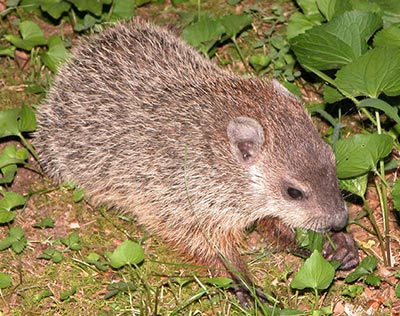| Quick Facts | |
|---|---|
| Length: | 25 in. |
| Weight | 4 lbs. |
| Region: | North America |
| Habitat: | Plains, Edges of Forests |
| Diet: | Herbivore |
| Conservation Status: | Least Concern (LC) |
| Linnaean Classification | |
| Kingdom: | Animalia |
| Phylum: | Chordata |
| Subphylum: | Vertebrata |
| Class: | Mammalia |
| Order: | Rodentia |
| Family: | Sciuridae |
| Genus: | Marmota |
| Species: | Marmota monax |
The Ground Hog, also known as the Woodchuck, is one of a large group of ground squirrels known as marmots. Measuring at approximately 25 inches and weighing approximately 4 pounds they have been known to grow larger especially in captivity. The Ground Hog has short but powerful arms with large curved claws meant for digging. The tail is short compared with other similar species. The spine is curved much like that of a mole. It has two coats of fur, one grey and dense, the other is made up of frosted colored guard hairs. This is what gives the Ground Hog its frosted shine in its fur.
Lifestyle
The Ground Hog lives over a large range all over North America including Alaska. It can live up to 6 years but has been known to live longer in captivity. The longest a known ground hog has lived is 22 years. Sexual maturity is achieved by its second year and can have 2-6 children per litter. The children are weaned and ready to leave within just a few weeks after birth.The Ground Hog eats grasses, berries, alfalfa, and many other agricultural plants. It can also eat small animals like insects and snails. It digs a burrow to sleep in, raise young, and hibernate. Each burrow can have 2-5 entrances. They can be quite large with up to 50 feet of tunnels, extending up to 5 ft underground. The Ground Hog prefers to live at the edges of woodland or in wide open country. It can often be a threat to agricultural crops as well as the structural integrity of buildings and machinery. Sometimes a Ground Hog will create a separate burrow for hibernation and will hibernate for 3-6 months depending of the local environment.
The Ground Hog is hunted by common predators lie wolves, foxes, bears, owls, and dogs. It can defend itself with large claws, and is adept at climbing and swimming to escape capture. It is often hunted but quick breeding helps the Ground Hog to maintain a population. Often, it will give a warning with a high pitched whistle to warn others of its kind.
Ground Hog Day
The Ground Hog is most popular during Groundhog day, celebrated every 2nd day of February. When the sky is cloudy and the Ground Hog emerges from its burrow, and then exits the burrow, this signifies that winter is almost over. When sunny and the Ground Hog sees its shadow and retreats back again into its burrow, winter still has several weeks to go. Large celebrations surround this event to watch the burrow and see if the Ground Hog emerges or not. The largest celebration is in Pennsylvania where the holiday began. It is common along the east coast as well as Canada and Texas.
